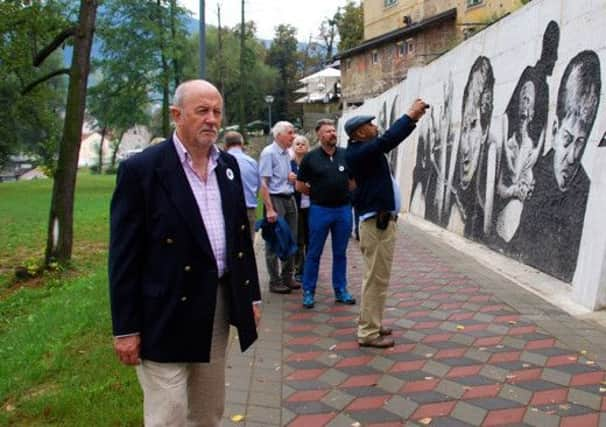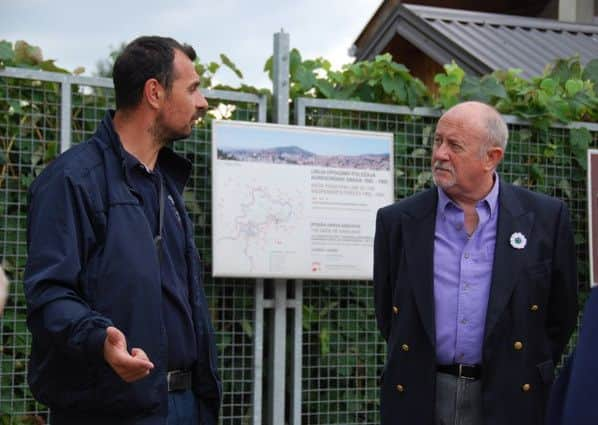Retired Fairlight police officer who helped bring war criminals to justice returns to Bosnia 20 years after Srebrenica


Ron Turnbull, who lives in Fairlight, played a key role in bringing war criminals such as Radovan Karadzic to face justice at The Hague when he was head of the Evidence Unit at the United Nations International Criminal Tribunal for the former Yugoslavia (ICTY).
Last month he returned to Bosnia 20 years after the first mass graves were excavated with a group of forensic experts who had also worked out there.
Advertisement
Hide AdAdvertisement
Hide AdThis offered a chance for Ron and others, who played such a key role in discovering the truth about the genocide in Srebrenica, to see the human side of it and pay their respects at the cemetery where more than 6,000 Bosnian Muslims are buried.


The delegation was led by Robert McNeil MBE, who sits on the board of Remembering Srebrenica Scotland, a charity set up to raise awareness of the genocide which took place 21 years ago.
The group also included specialists from many different fields who all played a role in the difficult task of exhuming bodies, examining victims, and gathering evidence against the perpetrators charged with war crimes, crimes against humanity and genocide.
As part of their visit, Ron and the delegation returned to Visoko, where a temporary mortuary in which they all worked was situated from 1997.
Advertisement
Hide AdAdvertisement
Hide AdThe town now has a Square of the Srebrenica Genocide Victims, which includes an amphitheatre, a fountain and a memorial plaque by the promenade. The memorial also recognises the work done by the forensic specialists in identifying the victims.
Reflecting on his time in Bosnia in the 1990s, Ron said: “After 25 years’ police service with Scotland Yard as a detective I thought I’d dealt with nearly every kind of homicide or terrorist atrocity.
“Due to the global reputation of Scotland Yard, officers are regularly requested by other countries to despatch personnel to assist with high profile cases. In this capacity I dealt with murders in Thailand, Sri Lanka, Zambia, Tanzania, Iraq and Canada.
“In July 1996 I was contacted by a leading pathologist, on behalf of the UK Foreign & Commonwealth Office (FCO) to ascertain if the Metropolitan Police Service (MPS) would consider despatching a homicide advisor to assist with exhumations and autopsies being conducted in Bosnia on victims of the war in Yugoslavia. ICTY sought expert aid in evidence retrieval procedures which would be acceptable in European courts in future prosecutions against war criminals.”
Advertisement
Hide AdAdvertisement
Hide AdRon was flown to Zagreb and joined a team from the charity, Physicians for Human Rights (PHR).
He said: “We were convoyed to Tuzla in Bosnia. The convoy consisted of white UN mini buses driven by civilian police officers from various countries, seconded to aid their Bosnian colleagues, and a number of lightly armed US military vehicles as escort.
“The destruction and desolation we saw and the gaunt, almost distant look on the faces of people we passed on the troublesome roads, pot-holed by artillery fire was alarming.
“This was a slow, nightmarish journey through many military check-points manned by young, bored looking soldiers in heavily armed and sand-bagged positions, some with battle tanks dug in around them. Helicopter gunships were seen and heard clattering around in the skies above.
Advertisement
Hide AdAdvertisement
Hide Ad“When we eventually reached Tuzla we were housed in various ‘safe houses’ and introduced to the team leaders, both of whom were US medical doctors.
“We were informed of mass graves identified by survivor and witness testimony, which had been under military guard and were to be excavated for ICTY.”
Ron went to a grave site near a village called Cerska in the Srebrenica region, which was the centre of hostile fighting.
He added: “We passed through small homesteads that had been systematically and dramatically imploded, reducing them to mere rubble. Shockingly obvious, and a vivid reminder of the ethnic cleansing which had occurred here, was the existence of recognisable national Serbian signs daubed in paint on some houses that stood relatively undamaged.
Advertisement
Hide AdAdvertisement
Hide Ad“An initial perimeter search of the surface of this grave revealed clusters of 7.62mm cartridges, indicating lines of fire. First soil removals exposed boxes of shoes then further excavation revealed skeletal remains. As the site progressed it was evident layers of bodies were contained to a depth of several metres. Most were co-mingled, bore signs of trauma, and firearm entry/exit wounds were commonplace.
“We found individuals dressed in home-made garments created out of military parachute material, some with curtain material as patches. We were aware some of these unfortunate individuals had been held in concentration camps for years and had to make do with whatever clothing material they could find in order to survive the severity of the Balkan winter.”
Ron said he remembers finding a photograph in a victim’s wallet which showed a woman and two little girls smiling in traditional costume.
He said: “It was wrapped inside a child’s crayoned drawing of a house and family. Two bullet holes had ripped through it. As I teased the photo out on a drying board using water, a scalpel and tweezers I became aware of a couple of female members of the team looking over my shoulder with tears in their eyes.
Advertisement
Hide AdAdvertisement
Hide Ad“I think the final insult of this cherished possession going to the grave with the father or loved one of these little girls and their mother, being destroyed thus preventing identification by the murderer’s bullet hit us all.”
A full post-mortem on each victim was carried out and evidence of torture, treated and untreated wounds, as well as ballistic evidence was recorded, Ron added.
“From 154 bodies in this one grave we retrieved 1,230 bullets,” he said.
Ron and his team also visited a grave site near Vukovar Hospital, again in the Srebrenica region.
Advertisement
Hide AdAdvertisement
Hide AdIntelligence claimed patients, doctors, nurses, Red Crescent workers and hospital staff had been taken away, killed and buried in a mass grave.
Of the 300 men known to be alive at the end of hostilities being treated in this hospital, 261 were missing, believed dead, Ron said.
He added: “This atrocity was carried out after UN observers visited the hospital but before armed peacekeepers could liberate and protect it. The hospital was under the command of JNA (the Yugoslav Army) and Serbian paramilitary troops. Doctors and nurses who tended prisoners of war were also killed when the UN forces started to enforce the ceasefire and endeavour to regain control. Several hundred medics were missing from this hospital, presumed dead.
“When I returned to ICTY in The Hague I helped set up protocols for various sites in the Balkans. I was so appalled and moved by what I had witnessed in Bosnia I felt compelled to channel my efforts and lend my expertise to assist with war crime investigations in this region where possible.
Advertisement
Hide AdAdvertisement
Hide Ad“With the support of senior MPS officers and the FCO I was able to do so, returning on several occasions in 1997/8 to Bosnia, Kosovo and Republic of Sprska with ICTY investigation teams to examine other sites and arrest perpetrators of war crimes.”
In 1999 Ron was instrumental in setting up the British Forensic Team (BFT) in Prizren, Kosovo.
Over the next six months volunteers from the UK, Australia and the Netherlands were brought in, incorporating pathologists, mortuary technicians, police photographers, body recovery teams, and CID detectives, as well as local interpreters, in order to investigate more than 70 separate sites of alleged massacres.
Ron added: “We recovered 524 bodies, of which 307 were identified and returned to their loved ones. This was a massive task carried out by dedicated staff to the highest standards and earned the BFT a great deal of respect within the military and local communities, as well as from the other national forensic teams so deployed.
Advertisement
Hide AdAdvertisement
Hide Ad“The BFT and I returned to Pristina, Kosovo in 2000 where we carried out another lengthy mission, recovering hundreds of bodies and a great deal of evidence for future use within trials at the tribunal.”
The ex-police officer took up his post as head of the Evidence Unit, ICTY in The Hague in 2002.
Ron said: “This unit not only dealt with evidence in the Milosevic trial but all of the other alleged war criminals indicted from the former Yugoslavia to face war crime charges relating to ethnic cleansing and other human rights atrocities, especially General Ratko Mladic and Radovan Karadzic.
“My function there was to ensure the integrity of this hard-won evidence was maintained and it be available for analysis and research by the investigators and attorneys tasked with bringing these cases to court at the tribunal. I had an excellent staff of 40 people from many varied disciplines who looked after more than 3.5 million documents and in excess of 6,000 hours of video evidence, over and above the physical artefacts.”
Advertisement
Hide AdAdvertisement
Hide AdSpeaking about last month’s return to Bosnia, Ron said he was ‘amazed’ at the ‘rejuvenation’ of the region.
He said: “Especially memorable was a courageous address by one of the Mothers of Srebrenica who spoke of the loss of her husband and son then and how it affected her and her daughter. The determination she displayed to keep living for her grandchildren, setting up a small business selling books, flowers and mementos outside the Dutch Bat base, where this all began, was humbling and her resilience and fortitude impressive.”
Don’t miss out on all the latest breaking news where you live.
Here are four ways you can be sure you’ll be amongst the first to know what’s going on.
1) Make our website your homepage
2) Like our Facebook page
3) Follow us on Twitter
Advertisement
Hide AdAdvertisement
Hide Ad4) Register with us by clicking on ‘sign in’ (top right corner). You can then receive our daily newsletter AND add your point of view to stories that you read here.
And do share with your family and friends - so they don’t miss out!
Always the first with your local news.
Be part of it.